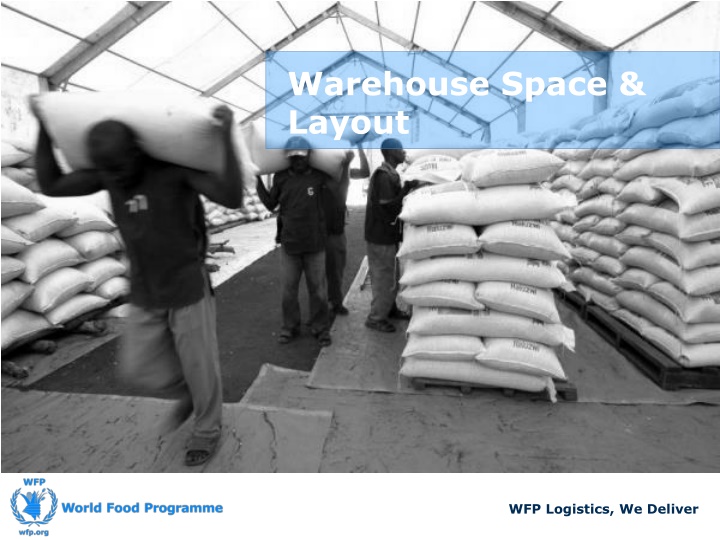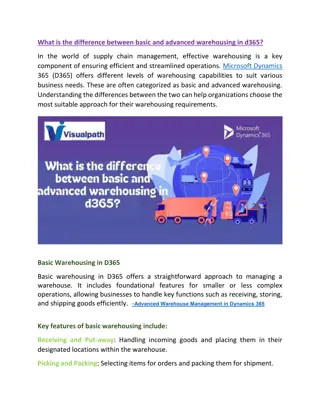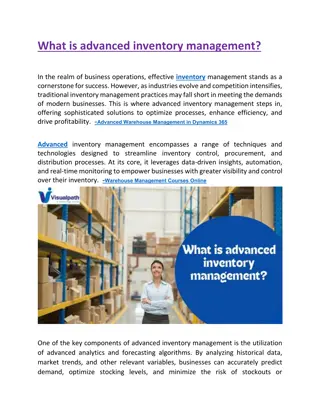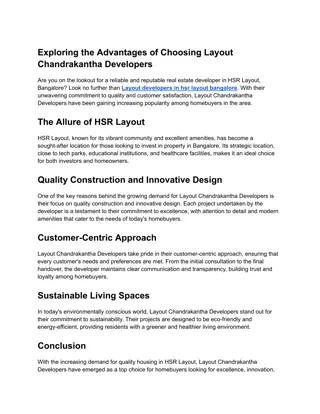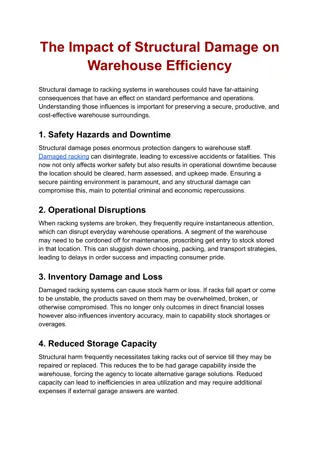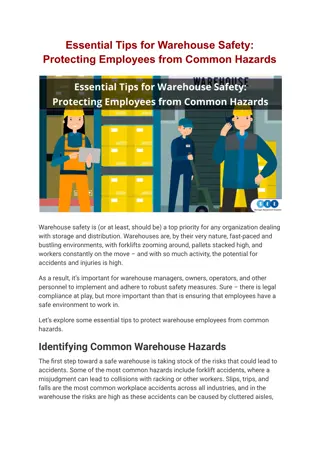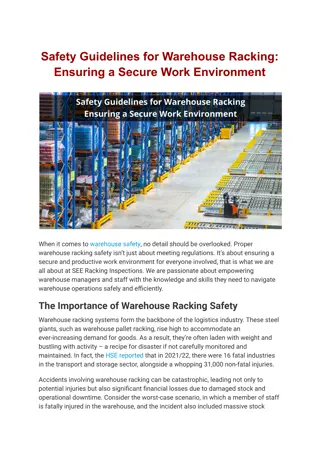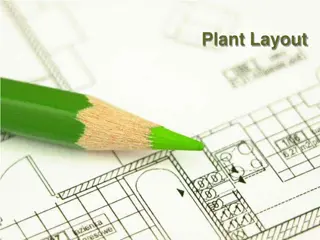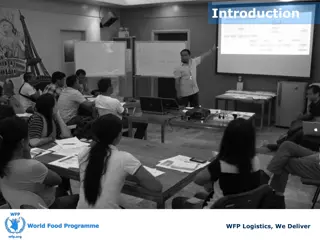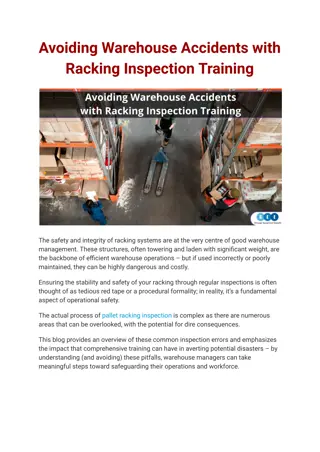Warehouse Space & Layout for Efficient Operations
Learn about warehouse functions, stacking methods, different areas in a warehouse, and common bad practices to avoid. Explore the importance of structural, organizational, and managerial elements in warehouse management. Understand the measurements, commodities, and warehouse KG weight. Enhance your knowledge on stacking methods such as unbonded stacking and bonded stacking, and how to calculate stacking capacity. Improve your skills in identifying space for spoiled packaging and utilizing stack cards for efficient warehouse operations.
Download Presentation

Please find below an Image/Link to download the presentation.
The content on the website is provided AS IS for your information and personal use only. It may not be sold, licensed, or shared on other websites without obtaining consent from the author.If you encounter any issues during the download, it is possible that the publisher has removed the file from their server.
You are allowed to download the files provided on this website for personal or commercial use, subject to the condition that they are used lawfully. All files are the property of their respective owners.
The content on the website is provided AS IS for your information and personal use only. It may not be sold, licensed, or shared on other websites without obtaining consent from the author.
E N D
Presentation Transcript
Warehouse Space & Layout WFP Logistics, We Deliver
Lesson Objectives By the end of this lesson, you will be able to: 1 Describe the different stacking methods Use the stowage factors and calculate the stacking capacity in a warehouse 2
Warehouse Functions Three Aspects to Consider Structural Elements Organizational Elements Managerial Elements
Different Areas in the Warehouse Work Area Goods receipt Picking/ Kitting Goods Dispatch Storage Repacking/ Recondition
Stacking Methods Clean area before creating stack Use good and clean pallets Select stacking method Identify space for spoiled and empty packaging Identify space for reconditioning & repackaging damaged cargo Use stack card
Stacking Methods Unbonded Stacking Bonded Stacking
Bad Practices The stack should be built to give a firm bonded or interlocked stack Do not stack so high that packages at the bottom are crushed or split Do not throw or drop X Remove projecting nails and splinters or the bottom bags may be torn and food spilt Do not stack close up to, or on top of, the roof beams so as to risk damaging the structure Do not stack too close to the roof reducing ventilation and access
Measurements Commodities and Warehouse KG Weight (1000 KG) MT SQM (M2) Length X Width Area CBM (M3) Volume Length X Width X Height
Calculating Maximum Stack Capacity Stack Characteristics: Height; Width; Length; Weight Stowage Factor = Volume / Weight
Stowage factor You have received a commodity in boxes with the following characteristics: Height Width Length Weight 15cm 45cm 60cm 0.025mtn What is the stowage factor of this commodity?
Stacking Exercise A. Calculate the stack capacity for the following: 1. 2. 3. Rice in 50 kg bags with a stowage factor of 1.5cbm/MT You have 70 pallets (size 1m x 1.2m) Maximum storage height: 3m B. What is the minimal number of pallets (1m x 1.2m) required to store 200 MT of a commodity that has a stowage factor of 2? 1. 2. 3. Maximum storage height: 2.5m How many pallets will you need to square off the surface of the pallets? What are the surface dimensions of the stack?
Stacking Exercise Answer (A) A. Calculate the stack capacity for the following: 1. 2. 3. Rice in 50 kg bags with a stowage factor of 1.5cbm/MT You have 70 pallets (size 1m x 1.2m) Maximum storage height: 3m Usable Surface Area = 70 x (1 x 1.2) = 84 sqm Usable Volume = 84 x 3 = 252 cbm Stack capacity = 252 /1.5 = 168 MT
Stacking Exercise Answer (B) B. What is the minimal number of pallets (1m x 1.2m) required to store 200 MT of a commodity that has a stowage factor of 2? 1. 2. Maximum storage height: 2.5m How many pallets will you need to square off the surface of the pallets? Step 1: Required volume (stack capacity) x (stowage factor) = (required volume) = 200 x 2 = 400 cbm Step 2: Required surface (required volume) / (max storage height) = (required surface) = 400 / 2.5 = 160 sqm Step 3: Minimum number of pallets (required surface) / (surface of pallet) = (minimum number of pallets) = 160 / 1.2 = 133.3 Step 4: Rounded quantity of pallets needed Pallet dimensions = 1 x 1.2 We plan for 8 pallets (1 meter side) wide floor The number of pallets per column is therefore = 133.3 / 8 = 16.6 = 17 pallets Number of pallets needed = 17 x 8 = 136 pallets
Stacking Exercise Answer (B) B. What is the minimal number of pallets (1m x 1.2m) required to store 200 MT of a commodity that has a stowage factor of 2? 3. What are the surface dimensions of the stack? ( Surface dimensions of a stack: 136 x 1.2 = 163.3 sqm
Warehouse Capacity Considerations Factors that affect warehouse storage capacity: Type, characteristics and compatibility of cargo Different storage requirements Warehouse size and structure Equipment Remember Available space = actual space + dispatches - receipts
Warehouse Layout Through-FLOW STORAGE AREA Truck Truck GOODS RECEIPT GOODS DESPATCH PICKING Truck Truck U-FLOW STORAGE AREA Truck GOODS RECEIPT & DESPATCH PICKING Truck
Lesson Recap Questions: 1 What are the different stacking methods? What is a stowage factor and how to calculate the stacking capacity in a warehouse? 2
Questions WFP Logistics, We Deliver
